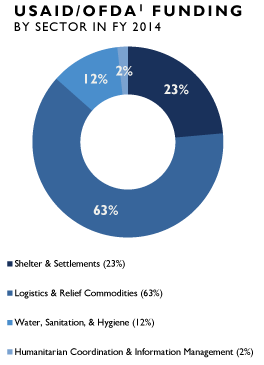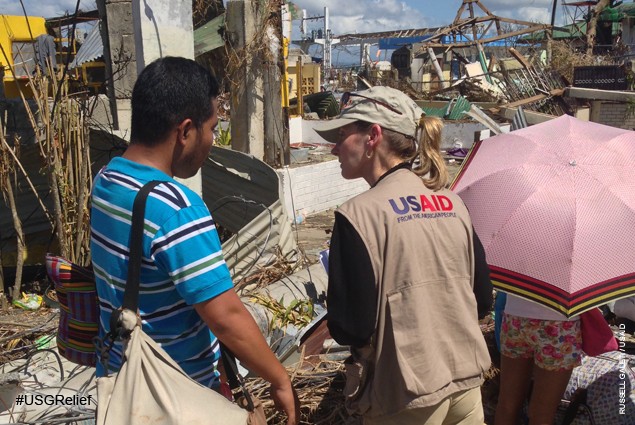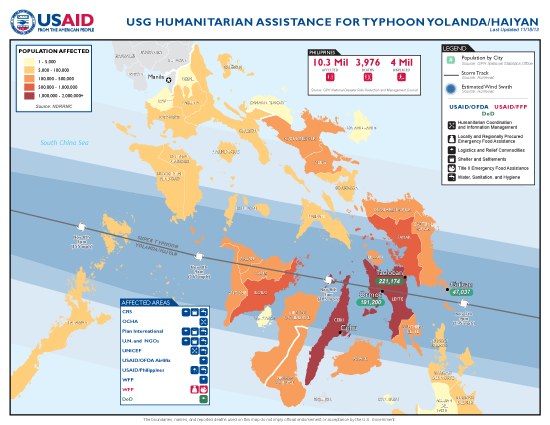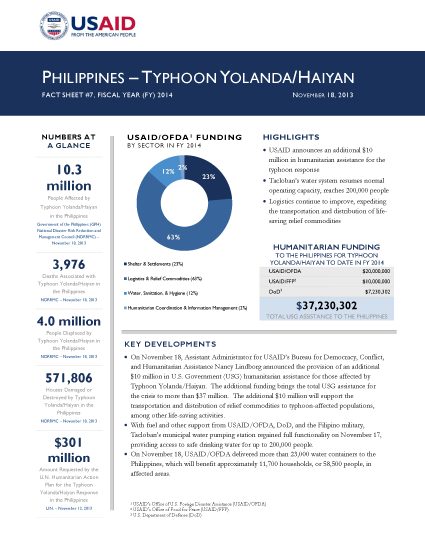- What We Do
- Agriculture and Food Security
- Democracy, Human Rights and Governance
- Economic Growth and Trade
- Education
- Ending Extreme Poverty
- Environment and Global Climate Change
- Gender Equality and Women's Empowerment
- Global Health
- Water and Sanitation
- Working in Crises and Conflict
- Disaster Assistance
- Political Transition Initiatives
- Conflict Mitigation and Prevention
- Countering Violent Extremism
- Disaster Risk Reduction
- Peacebuilding and Reconciliation
- Providing Safe & Secure Environments for Development
- Recovering From Crisis
- Resilience
- Tech Challenge for Atrocity Prevention
- World Humanitarian Day
- U.S. Global Development Lab
November 18, 2013
Numbers At A Glance
10.3 million
3,976
4.0 million
571,806
$301 million
Humanitarian Funding:
To The Philippines For Typhoon Haiyan/Yolanda To Date In FY2014:

| USAID/OFDA | $20,000,000 |
| USAID/FFP | $10,000,000 |
| DoD | $7,230,302 |
| TOTAL | $$37,230,302 |
Typhoon Haiyan / Yolanda Fact Sheet #7 - 11/18/2013 ![]() (pdf - 130k)
(pdf - 130k)
Highlights
USAID announces an additional $10 million in humanitarian assistance for the typhoon response
Tacloban's water system resumes normal operating capacity, reaches 200,000 people
Logistics continue to improve, expediting the transportation and distribution of lifesaving relief commodities
Key Developments
On November 18, Assistant Administrator for USAID's Bureau for Democracy, Conflict, and Humanitarian Assistance Nancy Lindborg announced the provision of an additional $10 million in U.S. Government (USG) humanitarian assistance for those affected by Typhoon Yolanda/Haiyan. The additional funding brings the total USG assistance for the crisis to more than $37 million. The additional $10 million will support the transportation and distribution of relief commodities to typhoon-affected populations, among other life-saving activities.
With fuel and other support from USAID/OFDA, DoD, and the Filipino military, Tacloban's municipal water pumping station regained full functionality on November 17, providing access to safe drinking water for up to 200,000 people.
On November 18, USAID/OFDA delivered more than 23,000 water containers to the Philippines, which will benefit approximately 11,700 households, or 58,500 people, in affected areas.
WASH AND HEALTH
- As of November 17, Tacloban’s municipal water pumping station was operating at full capacity due to fuel recently provided by the Filipino military, providing access to safe drinking water for at least 200,000 people in Tacloban city and six neighboring districts, according to the U.N. Children’s Fund (UNICEF). To maintain Tacloban’s newly restored water production system, DoD plans to continue providing fuel to the city’s municipal water pump station on an interim basis, until the Government of the Philippines (GPH) and humanitarian partners can organize additional fuel suppliers. Next steps include repairing water distribution lines and providing water to typhoon-affected populations residing in more remote areas.
- To minimize water, sanitation, and hygiene (WASH) risks, DoD's U.S. Marine Expeditionary Brigade is planning to procure, construct, and distribute 70 additional latrines to Tacloban and surrounding areas.
- Although humanitarian actors report no disease outbreaks in typhoon-affected areas to date, WASH and health experts note the potential for waterborne and climate-sensitive disease outbreaks, such as cholera, typhoid, dengue fever, and malaria. In response, USAID/Philippines has provided six solar-powered refrigerators to support upcoming joint GPH–U.N. World Health Organization immunization campaigns. USAID Disaster Assistance Response Team (DART) and DoD staff organized the transport of the refrigerators to the GPH Department of Social Welfare and Development (DSWD) warehouse in Tacloban. The GPH reports a need for medical equipment, including additional refrigerators, vaccine carriers, and vaccine stocks, to support the planned immunizations.
- To date, USAID/OFDA has provided approximately $1.6 million for WASH activities in storm-affected areas, including $750,000 to UNICEF, one of the lead agencies for the WASH Cluster—the coordinating body for WASH activities in the Philippines.
LOGISTICS AND RELIEF COMMODITIES

- Despite challenges, the overall logistics situation continues to improve, and the DART reports an increase in the speed and efficiency of relief distributions in Tacloban and surrounding areas. The DART deputy leader reports logistics at the Tacloban airport have significantly improved following several days of air traffic congestion, which resulted in the delayed delivery of relief supplies.
- Working from the DART's forward operating base at the Tacloban airport, a DART logistics officer and a military liaison officer coordinated the transport of 317 rolls of plastic sheeting and 138 hygiene kits supplied by the USG from the airport to the DSWD warehouse for onward distribution by DSWD and partners.
- As of November 17, DoD had transported approximately 860 metric tons (MT) of relief commodities to typhoonaffected areas of the Philippines, including nearly 700 MT to Tacloban and more than 80 MT to Guiuan city. U.S. military personnel with the USS George Washington are currently transporting USAID/OFDA and other donor organizations' relief commodities from Guiuan and Tacloban to outlying areas via airplane and helicopter.
- On November 17, DART logistics officers and DoD colleagues coordinated the transport of 100 UNICEF water kits to Tacloban. Each kit includes sufficient water containers, water purification tablets, buckets, and soap for 10 families; in total, the 100 kits are expected to benefit at least 5,000 individuals. The DART and DoD also coordinated the transport of additional emergency relief commodities from the Manila airport to the Villamore Air Base in preparation for forward distribution.
- On November 18, more than 23,000 collapsible water containers airlifted from USAID/OFDA's warehouse in Dubai, United Arab Emirates, arrived in Manila. The commodities will benefit approximately 11,700 households, or 58,500 people, with each family of five receiving two containers.
- To date, DoD has contributed more than $7 million for the Typhoon Yolanda/Haiyan response, primarily for airlifts and other logistical support. USAID/OFDA has provided approximately $8.5 million—representing approximately 63 percent of USAID/OFDA funding to date—for logistics support and relief commodities. USAID/OFDA’s total funding includes $5 million committed to WFP on November 17 to support logistics coordination and information management.
FOOD SECURITY
- As of November 17, Typhoon Yolanda/Haiyan had resulted in at least $154 million in agricultural damages, including damages to crops, livestock, fisheries, and irrigation facilities, according to the NDRRMC.
- The food security situation for typhoon-affected populations continues to improve, according to the U.N. World Food Program (WFP)—a lead coordinator for humanitarian logistics activities in the Philippines. Between November 13 and 16, WFP distributed family food packs—which included rice rations procured with USAID/FFP funding—to all municipalities in Leyte Province, reaching more than 763,000 people. Additionally, WFP provided high energy biscuits to approximately 33,000 people residing in evacuation shelters Tacloban city and other parts of Leyte Island. WFP plans to establish a logistical hub in Roxas city, Capiz Province, to bolster coordination and distribution efforts.
- To date, USAID/OFDA and USAID/FFP have committed $15 million toward WFP’s Typhoon Yolanda/Haiyan response in the Philippines for logistics and relief commodity support, as well as food assistance.
OTHER HUMANITARIAN ASSISTANCE
- On November 16, the American Red Cross (AmRC) committed an additional $5 million to support the Typhoon Yolanda/Haiyan response, bringing AmRC's total contribution to $11 million. AmRC will use the funding to purchase and distribute food and other relief commodities, including blankets, hygiene kits, and mosquito nets.
- As of November 18, international donors had pledged approximately $182.2 million to address humanitarian needs among populations affected by Typhoon Yolanda/Haiyan. The total amount pledged represents approximately 60 percent of the $301 million requested by the U.N. Humanitarian Action Plan for the Philippines typhoon response. *Funding









Comment
Make a general inquiry or suggest an improvement.